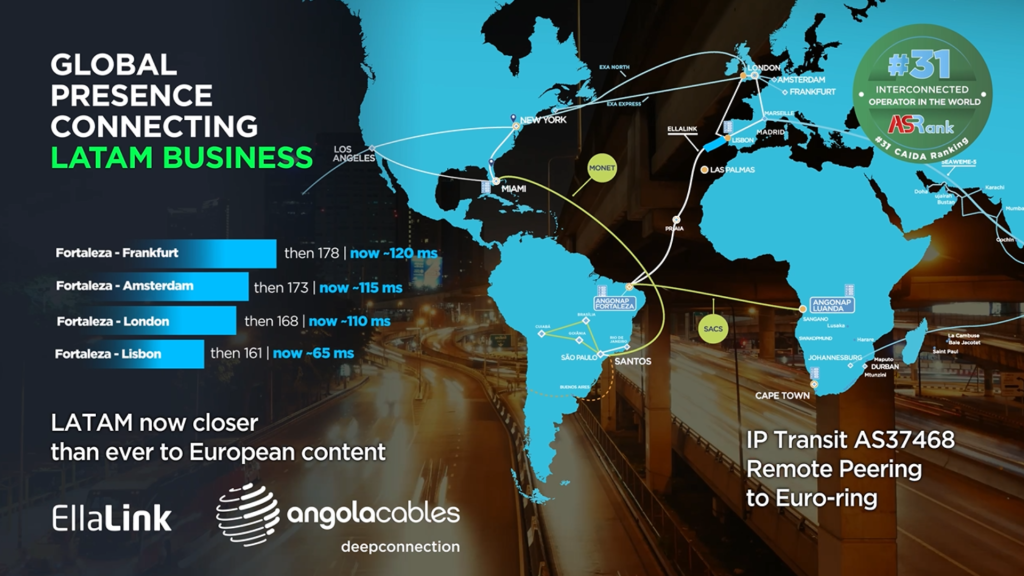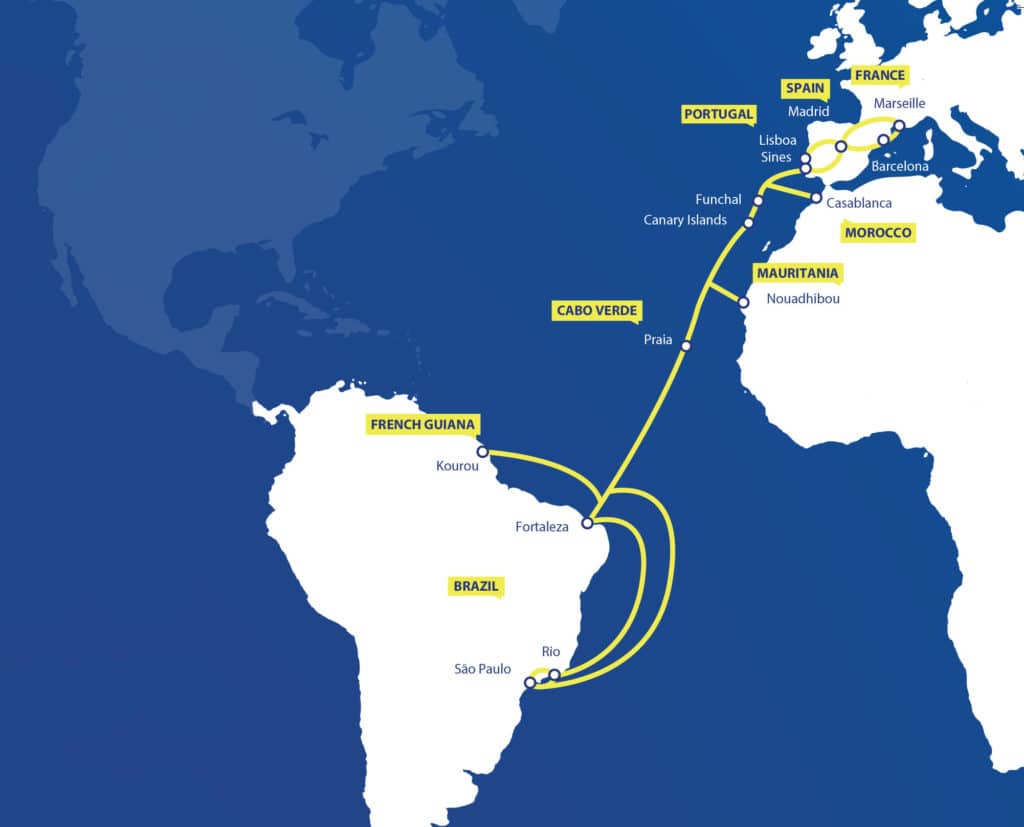Angola Cables & EllaLink: Transatlantic Connectivity Agreement
An unprecedented partnership, Angola Cables and EllaLink have come together to revolutionize transatlantic connectivity. This groundbreaking collaboration integrates transmission capacity across the Monet and EllaLink subsea cables, celebrating a new era of enhanced latency performance for Peering and IP Transit services traversing Brazil to Europe. A new era in global telecommunications rides, promising enhanced speed, reliability, and efficiency in data transmission across the Atlantic Ocean.
Reduced Latency Pioneers with Transatlantic Connectivity
With this Transatlantic Connectivity agreement, it is possible to experience an extraordinary decrease in latency along the submarine route, with remarkable improvements: up to 51% from São Paulo to Lisbon and an impressive 60% from Fortaleza.
These enhancements significantly strengthen the end-to-end connectivity pathways to Europe’s primary data exchange markets. From bustling hubs like London and Amsterdam to pivotal locations such as Frankfurt or Madrid, these advancements pave the way for faster and more reliable data transmission across the Atlantic.
By harnessing innovative technology and strategic infrastructure development, this partnership sets a new standard for high-performance data transmission and offers businesses unprecedented cutting-edge solutions.
EllaLink: the vanguard of low-latency Transatlantic Connectivity
With a transatlantic latency of under 60ms, the EllaLink submarine cable emerges as the beacon of low-latency, secure, high-capacity connectivity. It links key European cities - Sines, Lisbon, Madrid, and Marseille - with prominent Brazilian hubs, including Fortaleza, São Paulo, and Rio de Janeiro.

Ângelo Gama underscores the substantial benefits of latency reductions across various sectors: content sharing, cloud services, financial operations, gaming, and entertainment.
Reduced latency enhances content delivery in real-time and facilitates the seamless streaming of high-definition digital media, elevating the overall customer experience.
Gama elucidates how these advancements empower Angola Cables customers, particularly in facilitating Peering and IP Transit services. This enables the efficient dissemination and promotion of content across Portuguese and Spanish-speaking territories on both sides of the Atlantic, all achieved at unprecedentedly low latencies.
Forging Global Connections
The impact of these developments extends far beyond regional boundaries. By bridging Latin American countries and connecting to broader international audiences, the collaboration facilitates direct access from Miami, the US, where the Monet submarine cable lands, to South America and key European hubs in Spain, Portugal, and beyond.
Philippe Dumont, CEO of EllaLink, emphasizes the game-changing nature of this collaboration, asserting that both Angola Cables and EllaLink offer unparalleled differentiation for international bulk data traffic.
This partnership signifies a monumental leap forward in reducing latencies across markets Angola Cables serves. It leverages EllaLink's diverse route to seamlessly connect the continents of Europe and Latin America.
What is Transatlantic Connectivity?
Transatlantic Connectivity refers to the ability to establish communication and data transmission networks across the Atlantic Ocean, linking regions on both sides of the ocean.
This connectivity enables the exchange of information, data, and communications between countries and continents located on opposite shores of the Atlantic, facilitating various activities such as internet browsing, video conferencing, international phone calls, data sharing, and more.
Transatlantic connectivity is crucial in global telecommunications, business operations, research collaboration, and international relations.
Transatlantic Connectivity low-latency meaning
Low-latency Transatlantic Connectivity refers to establishing communication and data transmission networks across the Atlantic Ocean with minimal delay in data transfer.
"Latency" refers to the time it takes for data to travel from its source to its destination. In transatlantic communication, low-latency connectivity ensures that data travels quickly and efficiently between locations on both sides.
Low-latency Transatlantic Connectivity is essential for applications requiring real-time or near-real-time data transmission, such as video conferencing, online gaming, financial trading, and cloud services. By reducing the time it takes for data to travel across the ocean, low-latency connectivity improves the responsiveness and performance of these applications, enhancing user experience and enabling more efficient business operations.
Technological advancements, such as high-speed submarine fibre optic cables and optimized routing protocols, contribute to achieving low-latency Transatlantic Connectivity.
Companies like EllaLink and Angola Cables are crucial in developing and maintaining these infrastructure systems, which ensure reliable, high-performance communication between Europe and the Americas.
What is the relationship between Angola Cables & EllaLink and the Transatlantic Connectivity Deal?
The relationship between Angola Cables and EllaLink in the Transatlantic Connectivity Deal involves a collaborative effort to enhance communication and data transmission capabilities across the Atlantic Ocean.
Angola Cables is a telecommunications company based in Angola that specializes in developing and operating submarine fibre optic cable systems.
EllaLink, on the other hand, is a private consortium that has created the EllaLink submarine cable system, connecting Europe and South America.
In their agreement, Angola Cables and EllaLink have combined to optimize transatlantic connectivity by integrating their submarine cable systems. This collaboration aims to reduce latency, improve reliability, and increase bandwidth capacity for data transmission between Brazil and Europe.
By leveraging EllaLink's low-latency capabilities and Angola Cables' extensive network infrastructure, the partnership seeks to revolutionize communication between these continents.
Overall, the Transatlantic Connectivity Deal between Angola Cables and EllaLink represents a significant milestone in global telecommunications. It promises enhanced connectivity and communication opportunities for businesses, organizations, and individuals on both sides of the Atlantic Ocean.
What are high-speed submarine fibre optic cables?
High-speed submarine fibre optic cables are undersea communication cables designed to transmit data at high speeds over long distances. They consist of bundles of optical fibres encased in protective layers to withstand the harsh conditions of the ocean floor. These cables connect different parts of the world, facilitating international telecommunications, internet connectivity, and data transfer.
How do optical fibres submarine cables work:
- Optical Fibres: these cables contain multiple optical fibres made of glass or plastic, which transmit data as pulses of light. Each fibre can carry a vast amount of data.
- Transmission of data: data is converted into light signals at one end of the cable and sent through the optical fibres. The light signals travel through the fibres with minimal loss of signal strength.
- Repeater stations: Repeater stations are placed at intervals along the cable's route to boost and amplify the optical signals, ensuring they remain strong over long distances.
- Protective layers: submarine fibre optic cables are protected by multiple layers of materials, including insulation, strength members, and water-blocking materials, to shield the delicate optical fibres from damage caused by water pressure, marine life, and other environmental factors.
- Deployment and maintenance: these cables are laid on the ocean floor by specialized ships equipped with cable-laying machinery. Maintenance and repair of these cables require specialized equipment and expertise, often involving remotely operated vehicles (ROVs) for underwater work.
High-speed submarine fibre optic cables play a crucial role in global communications. They enable fast and reliable connectivity between continents and support various applications such as internet browsing, video streaming, international calls, and data exchange between businesses and individuals worldwide.
How does the Transatlantic Connectivity agreement reduce latency?
With the Transatlantic Connectivity agreement between Angola Cables and EllaLink, latency along the submarine route has decreased significantly. Specifically, there's an extraordinary improvement of up to 51% from São Paulo to Lisbon and 60% from Fortaleza.
These enhancements bolster end-to-end connectivity pathways to Europe's primary data exchange markets. From bustling hubs like London and Amsterdam to pivotal locales such as Frankfurt or Madrid, these advancements pave the way for faster and more reliable data transmission across the Atlantic.
What sets this partnership apart in terms of data transmission technology?
By leveraging innovative technology and strategic infrastructure development, the partnership between Angola Cables and EllaLink sets a new standard for high-performance data transmission. It offers businesses unprecedented cutting-edge solutions that revolutionize transatlantic connectivity, ensuring faster and more reliable communication between continents.
What is Transatlantic Connectivity, and why is it significant?
Transatlantic Connectivity refers to the ability to establish communication and data transmission networks across the Atlantic Ocean, connecting regions on both sides. This connectivity facilitates activities such as internet browsing, video conferencing, international calls, and data sharing. It's crucial for global telecommunications, business operations, research collaboration, and international relations.
What does Low-latency Transatlantic Connectivity mean?
Low-latency Transatlantic Connectivity refers to establishing communication and data transmission networks across the Atlantic Ocean with minimal delay in data transfer. It ensures quick and efficient data transmission between locations on both sides. This is vital for real-time applications like video conferencing, online gaming, financial trading, and cloud services, enhancing user experience and enabling efficient business operations.
How do High-speed Submarine fibre Optic Cables work, and why are they important?
High-speed submarine fibre optic cables are undersea cables designed to transmit data at high speeds over long distances. They contain optical fibres that transmit data as light pulses, protected by layers to withstand ocean conditions. These cables are crucial in global communications, enabling fast and reliable connectivity between continents and supporting various applications like internet browsing, video streaming, and international calls.
What is the relationship between Angola Cables & EllaLink in the Transatlantic Connectivity Deal?
Angola Cables and EllaLink have collaborated to enhance communication and data transmission across the Atlantic Ocean. Angola Cables specializes in submarine fibre optic cable systems, while EllaLink created the EllaLink submarine cable system to connect Europe and South America. Their agreement integrates their systems to optimize transatlantic connectivity, aiming to reduce latency, improve reliability, and increase bandwidth capacity for data transmission between Brazil and Europe.
You May Also Like
Sines to Lisbon: The new submarine cable by EllaLink
EllaLink new submarine cable connects Europe to South America from Portugal to Brazil. This connecti
EllaLink has been shortlisted for CC – Global Awards 2020 in the category ‘Connecting the Unconnected’ and here is why.
Connecting the Unconnected EllaLink has created for the first time the possibility of moving massi
EllaLink won a Global Carrier Award for “Best Subsea Project of the Year”.
For the second consecutive year EllaLink has won a Global Carrier Award in the illustrious category


